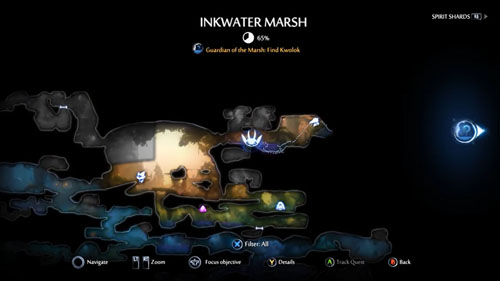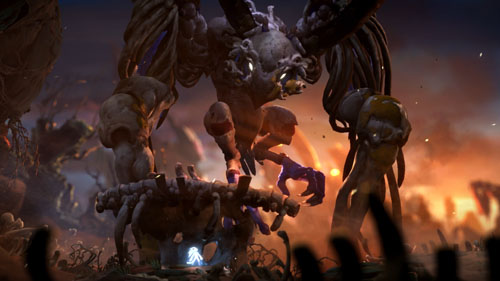A game by Moon Studios for PC, Switch, Xbox One, and Xbox X/S, originally released in 2020.
Ori and the Will of the Wisps is the follow-up to Ori and the Blind Forest, and the game once again stars Ori, a forest spirit who lives with his adoptive mother, Naru, and a long-legged forest creature named Gumo. In the first game, Ori faced off against a giant owl named Kuro during his quest to restore the Spirit Tree and return balance to the world. The game ended with Kuro giving her life in an attempt to save her last remaining child, who sat newly hatched within the branches of the Spirit Tree. With her final sacrifice, the Spirit Tree was saved, as was her now-orphaned hatchling.Ori and the Will of the Wisps picks up where the last game left off, with Ori, Naru, and Gumo working together as a family to care for the young owl, whom they name Ku. A partially interactive prologue – played out mostly in pantomime – shows the seasons passing as the family attempts to raise Ku into adulthood… but Ku has a damaged wing that prevents her from being able to fly on her own.
Ori remembers that he has one of Kuro’s feathers, which Gumo binds to Ku’s wing to allow her to fly. Ori hops on Ku’s back and they fly away in triumph, but a raging storm rises unexpectedly, causing Ku to lose her mother’s feather, and separating the two from one another in the forest.
Ori awakens in the forest, once again alone, and he embarks on a journey to locate Ku and reunite with his family. Along the way, he learns that there is still work to be done to restore the land, and so he sets out to explore a vast environment and ultimately to find the titular wisps. This is a heartfelt journey filled with love and loss, and set in an absolutely stunning world.
There are multiple biomes to explore, each packed with details and lighting effects that emphasize the murky depths of the swamp, the lush and colorful springs, the sandblasted desert, and the frigid arctic. There are plenty of little flourishes and reactive bits of the environment, along with grand setpiece moments that help to set the mood of the experience, all accompanied by a sweeping score that emphasizes moments of adventure, longing, and danger.
As before, this is a metroidvania, with a large interconnected map that slowly fills in as you explore, and side paths becoming accessible as new abilities are gained. There is a cartographer who offers to sell maps of each region, which show the general layout but remain drained of color until you reach them. Icons indicate save points, collectibles (once you’ve gotten close enough to them), and quests. You can play the game as a largely linear experience if you simply move from one quest to the next, and you can warp between save points to speed things along. Or you can take on side quests and explore every corner to look for currency, permanent health and energy upgrades, and shards that are used to increase your stats and abilities.
At first, you’re limited to just a few abiliy slots, and so you can only equip a small number of upgrades, but you slowly unlock additional slots as you explore, eventually allowing you to take advantage of numerous skills and buffs. These include additional units of health or energy, the ability to deflect projectiles, increased chances for certain drops from enemies, enhancements to your energy-based projectile attacks, and even ones that make the game more challenging but also grant additional rewards, and several of these shards can be upgraded as well.
Ori begins his quest with none of the abilities he acquired in the previous game, and no attempt is made to explain why this is the case. He starts out with a speedy run, a long jump, and the ability to scramble up vertical surfaces. Scrambling is done with repeated presses of the JUMP button, which requires a lot of effort for climbing and especially for triangle jumping… but you soon acquire a shard that allows you stick to walls and climb them.
Throughout your adventure, you gain several new movement abilities, including a double jump, a triple jump, and the ability to glide using Kuro’s feather (which you experiment with for a short while during the prologue). The double and triple jump offer very little vertical height, making it somewhat frustrating to reach ledges that are above you but just out of reach. As such, some secrets may only be uncovered by skilled players who can manage multiple very precise button presses. On the other hand, these jumps – and the glide – allow for much greater horizontal exploration, as much of the game’s progression is gated behind long jumps.
Also returning from the previous game is the bash maneuver, and you unlock this pretty early on. As before, this move allows you to lock onto enemies, projectiles, and certain objects in the environment, and doing so slows down time for a moment. During this time, you can select a direction and let off the button, which lets you fling yourself a short distance in that direction. This is used for basic environmental navigation as well as challenges where you must time your jumps and bashes to hop between multiple enemy projectiles in succession. Furthermore, not only does bashing fling you in one direction, it flings whatever you grabbed in the opposite direction, allowing you to send projectiles back at enemies and also to break open barriers that are otherwise impenetrable.
You also gain a grapple maneuver that works similarly (it’s assigned to the same button), but it lets you grab objects from a much greater distance. This maneuver is used to pull yourself toward objects rather than flinging, although it can also cause confusion during action sequences as the bash maneuver requires much closer proximity to use… and you have to watch out for different colored flower buds, since some can be grappled and some can be bashed. As the game goes on, you’ll also be tunneling, floating on air currents, and swimming underwater.
There’s quite a lot of variety in the mechanics and the methods for solving puzzles in each area, with some taking the form of basic switch-and-door puzzles, while others extend across multiple screens and require a series of maneuvers to complete. For instance, you may find yourself unjamming a series of wheels by destroying the growths that are gumming them up. These spinning wheels act as gears that turn other wheels in the area, transforming the landscape as you jump and grapple between spinning platforms… ultimately leading to the movement of a giant water wheel that you can ride around and use to reach a higher area.
Environmental puzzle solving and traversal are the focus here, and many enemies are in place as a means of performing these actions (e.g., bashing enemy projectiles lets you gain height), but there are occasions where you’ll need to actively engage your foes. You have a melee strike that has a decent range and a 5-hit combo, but it’s quite weak, making it somewhat arduous to take down even moderately powerful enemies… which slows the experience somewhat.
But you can also equip three abilities to your action buttons, and these include a number of different projectile attacks that allow you to hit targets at a distance, as well as a hammer – with its own 3-hit combo – that delivers slow but heavy damage up close, and these moves can be upgraded as well. It even has a downward strike that can be upgraded to send shockwaves outward to the left or right. Pressing UP or DOWN when using your melee strikes changes up your combo to hit enemies above or below you.
There are occasional arena encounters where you must fight multiple enemies to make your way forward, as well as optional combat challenges that increase the number of shards you can equip at once. You must also take down some very powerful foes that act as miniboss encounters and put your combat and evasion skills to the test.
Larger scale encounters with towering enemies tend to be more focused on environmental navigation rather than traditional boss encounters… although you do sometimes engage with bosses directly, but even these are interspersed with chase sequences. In these sequences, you’ll need to outrun rampaging beasts or environmental hazards through deft movement, or avoid the watchful eye of Shriek – the game’s terrifying antagonist – as he hunts you down. These sequences must be repeated from scratch if you are killed, with most mistakes resulting in instant death, requiring a bit of memorization (or very quick reflexes).
The game is filled with surprises and discoveries, with new areas to be found and secrets to uncover, combined with a map system that makes it difficult to get lost despite the size and complexity of the world. There are only a few minor issues that tarnish an otherwise phenomenal experience, and these come from instances where enemies are occasionally obscured by objects in the foreground, a couple of glitches that require a reloaded save to fix, a camera that sometimes falls behind if you change directions or fall unexpectedly, and the regular use of strong light sources directly behind your character (who is a glowing blue spirit) essentially making him invisible as you’re trying to complete complex platforming challenges.
2D CRED
Ori and the Will of the Wisps was developed by Moon Studios, a studio founded in 2010 by Thomas Mahler and Gennadiy Korol. The studio previously released Ori and the Blind Forest.
The studio is a first party developer for Microsoft, which is the game’s publisher.






























0 comments:
Post a Comment